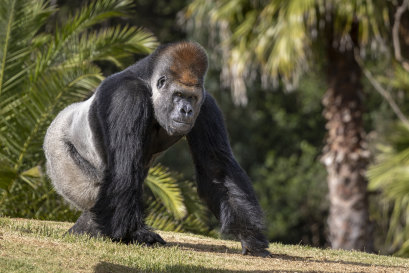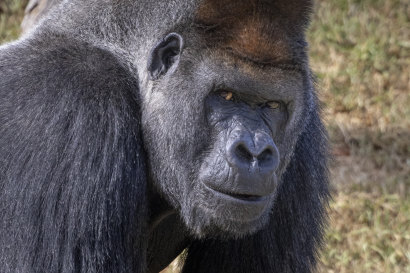Big-hearted project tracks cardiovascular disease in great apes
By Bianca Hall
It’s the question being asked at zoos around the world: why are gorillas, bonobos, chimpanzees and orangutans so prone to cardiovascular disease in captivity?
Specifically, why are they prone to a form of heart disease called fibrosing cardiomyopathy, which transforms healthy muscle into fibrous bands of scar tissue that become too rigid to pump blood?

Werribee Open Range Zoo’s Motaba, aged 40, is considered a geriatric gorilla.Credit: Zoos Victoria
A global team of zookeepers, veterinarians and hospital technicians has spent years on a ground-breaking research project that – it is hoped – will help diagnose, treat and prevent heart disease in critically endangered species like gorillas.
The Great Ape Heart Project, based at Detroit Zoo, grew from increasing awareness since the 1990s of the propensity of great apes – particularly older male gorillas – to develop cardiovascular disease in captivity.
Despite decades of work, experts are yet to reach consensus on whether diet, activity levels, advanced age or captivity itself could be the cause.
Under the project, participating zoos send heart-monitoring results – and the hearts of great apes who have died – to Detroit for inclusion in a centralised database to co-ordinate research into cardiovascular disease.
Thanks to the Royal Children’s Hospital in Melbourne, the data sent by Zoos Victoria will be collected in a groundbreaking new way: with the gorillas’ consent, and while they are conscious.
Veterinarian Dr Kate Bodley said that early on, vet teams had conducted ultrasounds on great apes’ hearts under general anaesthetic. Sedation, however, can affect the functioning of apes’ hearts while they’re under – altering the very thing vets seek to measure.
Enter children’s doctors, who are used to dealing with wriggly and unco-operative patients.
In 2000, Bodley and her team approached cardiologists at the Royal Children’s Hospital for help monitoring the hearts of great apes while they are awake.
Director of cardiology at the Royal Children’s Hospital, Professor Michael Cheung, said his team was “familiar with examinations where the patients aren’t completely co-operative”.

Motaba, 40, has learned to tolerate keepers testing his heart.Credit: Zoos Victoria
“There has to be a greater level of patience and acceptance that you may not be able to get all the images that you want, and you may have to do it in a different order to how you typically acquire the images,” he said.
After years of training with both hospital and zoo staff, two gorillas – Werribee Open Range Zoo’s Motaba and Melbourne Zoo’s Otana – now willingly allow staff to use hand-held devices to conduct echocardiogram and electrocardiogram ultrasounds.
Motaba – who at 40 is considered geriatric – was diagnosed with clinical signs of cardiovascular disease in 2007, making regular monitoring crucial.
In audio recorded at Werribee Open Range Zoo, Motaba can be heard letting out a bone-chilling grumble as he pushes himself towards the bars separating him and his keeper, to allow them to examine his heartbeat.
Motaba has already outlived many of his wild counterparts, who have a life expectancy of 35. In captivity, if his heart disease is kept in check, he could live for another 20 years.
Unlike an adult human patient, for whom an echocardiogram could take 30 minutes, vets and sonographers are limited by the gorillas’ patience in tolerating ultrasound testing. Some tests take multiple attempts.
“This is an entirely voluntary process on the part of the gorillas,” Bodley said. “We’re asking them to do something using positive reinforcement techniques like some food … if Otana does not want to sit for his cardiogram on a particular day, then he doesn’t do it.”
Despite the challenges, the success of the consent-led approach – borne from four years of training and careful collaboration – has been hailed by zoo staff as remarkable.
“I could never have imagined us being able to achieve this diagnostic procedure with an animal volunteering,” Bodley said. “The amazing development of training as a way of doing proactive health monitoring in zoos is just really remarkable.”
The Morning Edition newsletter is our guide to the day’s most important and interesting stories, analysis and insights. Sign up here.